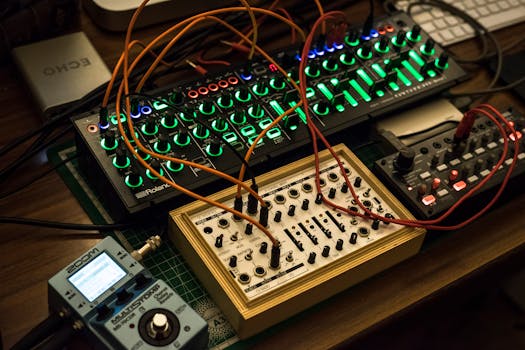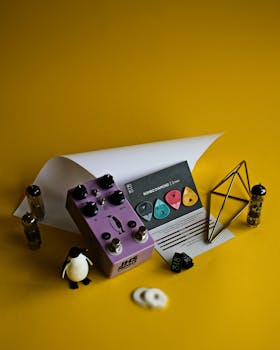Best Soft Synthesizer
As an Amazon Services LLC Associates Program participant, we earn advertising fees by linking to Amazon, at no extra cost to you.
Comparison of Popular Soft Synthesizers
I’ve found that choosing the right soft synthesizer can significantly impact my music production experience. There are several popular options that stand out for their unique features and sound design capabilities. For instance, Serum is renowned for its wavetable synthesis. The user interface is intuitive, and it allows for deep modulation options, making it a favorite among electronic music producers. The sound quality is pristine, which I personally appreciate when sculpting intricate soundscapes.
In contrast, Native Instruments’ Massive X offers a flexible architecture that’s fantastic for creating bass and lead sounds. Its modulation capabilities are powerful, allowing for complex routing that can yield unexpected and inspiring results. I tend to lean on Massive X for heavier, aggressive sounds due to its distinct character.
Then there’s Omnisphere, a powerhouse of a synthesizer that combines various synthesis methods. The sample library is extensive, offering a plethora of sounds, which is perfect for film scoring or adding depth to my tracks. Its atmospheric presets are among my favorites, providing a rich textural backdrop without much effort.
If I need something lightweight, I often turn to Arturia’s Pigments. Its hybrid synthesis approach blends wavetable and subtractive synthesis, giving me a wide range of sonic possibilities without taxing my CPU. The visual interface makes it easy to understand my sound design process, and the presets are diverse, catering to various genres.
Lastly, I can’t overlook u-he Diva, which emulates iconic analog synths. The sound quality is superb, and the way it captures the warmth of analog circuitry is impressive. I enjoy using Diva for lush pads and rich bass lines, and the hands-on feel in programming makes it a delight to work with.
Each synthesizer has its strengths and caters to different needs, but the best choice ultimately comes down to personal preference and the specific sound I aim to achieve in my projects.
Key advantages of soft synthesizers over hardware
Explore the benefits that software synthesizers bring to music production compared to traditional hardware.
- Cost-effectiveness: Soft synths are generally much cheaper than acquiring multiple hardware synthesizers, which can cost thousands.
- Compactness: They don’t take up physical space, allowing me to have an entire studio’s worth of sounds in a laptop.
- Instant recall: It’s so easy to save and recall presets; I can switch between different sounds on the fly without fiddling with cables.
- Easier integration: Connecting soft synths to digital audio workstations is straightforward, making the workflow smoother and more productive.
- Unlimited flexibility: With software, I can modify sounds infinitely, using an array of effects and tweaking parameters without limitations.
- Access to a vast library: There are countless soft synths and plugins available, offering an extensive range of sounds that hardware can’t match easily.
- Frequent updates: Software often receives updates and new features, ensuring I can keep my tools cutting-edge without purchasing new hardware.
Top 5 Soft Synthesizers for Every Musician
1. Serum by Xfer Records – Serum is my go-to for wavetable synthesis. The interface is intuitive, allowing for real-time playback of changes. I love how flexible it is; creating complex sounds is straightforward yet powerful. The quality of the audio is unmatched, and it has become a staple in countless tracks across genres.
2. Massive X by Native Instruments – Massive X is indispensable for creating rich and evolving sounds. I particularly enjoy its modular approach, which opens up endless sonic possibilities. The visual representation of sound design makes it easy to see what’s happening under the hood, and the in-depth functionality really sets it apart.
3. Omnisphere by Spectrasonics – Omnisphere has a deep library full of sounds that spans various genres. I appreciate its ability to blend different textures and styles seamlessly. The sound engine is powerful, and the variety of presets means I can find inspiration quickly without getting bogged down in programming from scratch.
4. Sylenth1 by LennarDigital – Sylenth1 offers a classic, analog sound that I frequently rely on. Its rich presets are perfect for dance music, and the simplicity of its design means I can easily tweak sounds without losing time. It’s lightweight on CPU resources, which is essential when working with multiple tracks in a session.
5. Logic Pro X Alchemy – Alchemy is an incredibly versatile synthesizer included in Logic Pro X. The additive and spectral synthesis capabilities are excellent for experimental sounds. I love its built-in sampling features, which let me manipulate sounds in real-time, giving me a level of creativity that’s hard to match.
Features to Look for in a Soft Synthesizer
The variety of features in a soft synthesizer can greatly influence your music production experience. One crucial aspect is the sound engine. Look for a synth that offers multiple synthesis methods, such as subtractive, FM, additive, and wavetable synthesis. This variety allows for diverse sound design, enabling you to explore different sonic textures and timbres.
Another essential feature is the modulation capabilities. A soft synth should come with an extensive modulation matrix that allows you to assign different parameters to LFOs, envelopes, and even step sequencers. Flexible modulation opens up creative pathways that can transform a basic sound into something extraordinary.
The user interface plays a significant role in how fluently you can navigate the synth. Look for one with an intuitive layout that makes it easy to understand and manipulate parameters without feeling overwhelmed. An effective interface can save you time and keep your creative flow intact.
Built-in effects are also a must-have. Reverb, delay, distortion, and modulation effects can significantly shape your sound right within the synth, allowing you to experiment without the need for external plugins.
Compatibility with MIDI controllers and DAWs is vital. Make sure the synth supports your preferred workflow and can be integrated without fuss. A synth that can adapt to your existing setup enhances your overall music production experience.
Lastly, consider the quality and variety of presets available. A solid bank of factory presets can serve as inspiration, helping you to jumpstart your creative process. Look for a synth that not only has a large collection of sounds but also provides options that suit your preferred genres.
Exploring the Latest Trends in Soft Synthesizer Technology
The evolution of soft synthesizers has fundamentally changed how we produce and create music. The integration of advanced audio engines and intuitive interfaces is allowing creators to realize their visions more efficiently. One significant trend is the rise of modular soft synths, where users can customize their setups with virtual modules to create unique soundscapes. These platforms often replicate the flexibility of hardware modular systems but with the convenience of a computer-based environment.
Another exciting trend is the incorporation of artificial intelligence and algorithmic composition in soft synths. AI-driven tools are revolutionizing sound design by providing musicians with smart suggestions and generative capabilities. Synths that learn from user preferences and adapt to their style introduce a level of creativity that was once unimaginable. It’s fascinating how these tools can assist both novice and seasoned musicians in exploring new sonic territories.
Moreover, enhanced visual interfaces are another standout trend. Developers are moving towards more visually engaging layouts that reflect the sound manipulation in real-time. These interfaces not only simplify the workflow, but they also make the process of sound design an inspiring and creative experience. This push towards improved UX (user experience) is making it easier to dive into complex sound creation.
The subscription model for soft synthesizers is also gaining traction. Rather than making a significant upfront investment, musicians can now access a broad array of plugins and instruments for a monthly fee. This democratization of technology allows smaller producers and hobbyists to experiment with high-quality tools without a hefty price tag.
Lastly, cross-platform compatibility is becoming essential. Soft synths are increasingly designed to work across multiple devices, from desktops to tablets and smartphones. This flexibility not only enhances portability but also provides musicians with the ability to create music anytime and anywhere. The trend towards incorporating features like cloud saving and collaborative sessions further enhances this connectivity.
Frequently Recommended Soft Synths by Professionals
In the world of music production, soft synths have become an indispensable tool for professionals. Among the most recommended is Serum by Xfer Records. Its wavetable synthesis capabilities and intuitive interface make it a favorite among producers across genres. The sound design possibilities are almost limitless, and the quality is outstanding.
Another heavyweight is Native Instruments’ Massive X. This is the evolution of the original Massive, known for its powerful bass sounds and evolving textures. The modulation options are extensive, allowing for intricate sound manipulation that many find invaluable in their productions.
Arturia’s Pigments is also worth mentioning. What truly sets Pigments apart is its hybrid approach, combining subtractive and wavetable synthesis, allowing for creative sound design that’s not only unique but also user-friendly. The visual interface is stunning and makes it easy to understand even the most complex sounds.
For those looking for a vintage sound, Sylenth1 by LennarDigital is a classic choice. It emulates analog sounds beautifully and has been a staple in electronic music for years. Its straightforward interface and high-quality presets keep it at the top of the must-have list for many professionals.
Yet another fantastic option is Spitfire Audio’s LABS. While it is more of a sample-based synth, the quality of its sounds and ease of use make it a go-to for cinematic scores. The free aspect certainly doesn’t hurt its popularity, allowing musicians to access lush soundscapes without breaking the bank.
Lastly, the ever-popular Kontakt from Native Instruments cannot be overlooked. While primarily a sampler, its vast library of instruments and seamless integration with a multitude of sound libraries gives it unmatched flexibility. This is essential for anyone looking to expand their toolkit with realistic instrument sounds.
All these soft synths have their unique qualities that resonate with professionals across the music production spectrum. Choosing the right one often comes down to personal preference and specific project needs. Experimenting with different options is the best way to find what truly enhances your production style.
Innovative features that enhance your music production
Cutting-edge tools that can elevate your music creation experience.
- Advanced MIDI capabilities: The latest generation of digital audio workstations (DAWs) offers unprecedented MIDI functionality, allowing for expressive note manipulation that can transform basic melodies into intricate compositions.
- AI-driven mixing tools: Incorporating artificial intelligence in mixing can automatically analyze your track and suggest optimal balance settings, saving hours of tedious adjustments while providing a polished sound.
- Virtual instruments with realistic sound engines: The newest virtual instruments use sampling technology that captures the nuances of live performances, giving you an authentic sound without needing the physical instrument.
- Real-time collaboration features: New platforms allow multiple users to work together in real-time, enabling musicians across the globe to create and refine music together seamlessly, enhancing creativity and collaboration.
- Enhanced audio effects: Innovative plugins provide unique audio effects that can dramatically alter timbres and textures, making even the simplest tracks stand out with fresh sounds.
- Mobile music production apps: The rise of sophisticated mobile apps means you can produce and edit music anywhere. These apps come with many features, from recording to mixing, all in your pocket.
The Benefits of Using Soft Synths
Soft synths offer unparalleled flexibility for music production. With countless virtual instruments available, you can recreate virtually any sound imaginable. Whether I’m after a thick analog pad or a sharp digital lead, soft synths provide instant access to diverse sound palettes. This accessibility allows for more experimentation without the commitment of hardware investment. The convenience of soft synths cannot be overstated. I love that I can take my entire studio with me on my laptop. Gone are the days of lugging heavy equipment to gigs or sessions. All my favorite sounds are just a click away, making improvisation and collaboration easier than ever. The ability to save presets means that I can quickly recall sounds that work for my projects. Another major advantage is the cost-effectiveness. High-quality soft synths are often significantly cheaper than their hardware counterparts. Many top-tier plugins even offer free or low-cost versions, making it possible for anyone to start producing music without breaking the bank. I appreciate this democratization of music production, enabling more creative voices to emerge. Moreover, soft synths frequently come with built-in effects and modulation options. I find that having everything in one interface streamlines my workflow. The capability to automate parameters and incorporate extensive modulation makes sound design incredibly intuitive. This level of integration is a game-changer for anyone looking to push their creative boundaries. Lastly, the continual updates and community support surrounding software synths mean I can always stay in touch with the latest sounds and techniques. As new features roll out, I find myself inspired to revisit projects and explore fresh ideas. This ever-evolving nature keeps my creativity alive and engaged.
Essential Settings for Soft Synths
These settings are crucial to enhancing your experience with soft synths, allowing you to create more expressive and polished sounds.
- Oscillator Types: Experiment with different oscillator waveforms such as sawtooth, square, and sine to find the right character for your sound.
- Filter Cutoff and Resonance: Adjust the cutoff frequency to shape your sound’s timbre and use resonance to accentuate certain frequencies for more presence.
- Envelope Settings: Tweak the attack, decay, sustain, and release settings to control how your sound evolves over time, impacting its punch and smoothness.
- LFO Modulation: Utilize low-frequency oscillators to add movement and modulation. Experiment with rate and depth to create pulsating effects or subtle changes.
- Effects Processing: Apply reverb, delay, and distortion judiciously. These can enhance spatial characteristics and richness, but avoid overdoing it.
- MIDI Controller Integration: Map controller knobs and sliders for hands-on control. This makes tweaking parameters real-time, which can ignite creativity.
- Polyphony Settings: Decide how many notes can play simultaneously. This is crucial when layering sounds or creating thick chords.
- Output Levels: Constantly check your output levels to avoid clipping. A clean signal often translates into better mixes.
- Presets and Custom Sounds: Save your favorite settings as presets. This not only speeds up your workflow but also allows you to easily return to killer sounds.
Nov 15, 2023 … And is getting a Roland Fantom on top of these redundant? RIght now I have Komplete and Arturia V Collection, will …
What are **THE essential software synths/suites to own these days …
Jul 25, 2021 … Hello everyone, I know the answer is subjective, but I want to ask you all, "What do you think is the best software synthesizer?
Best soft-synth? – Instruments & Effects – Cakewalk Discuss | The …
Jun 6, 2022 … The ones I use the most are VOPM_ex (4-op FM), basic65 (C64-inspired synth), Korg Gadget (suite of 20 or so very useful VSTs, including an …
Feb 15, 2024 … … synthesizer, effects processor, and patch player, the Hyperion … The BEST Software PAD Synths in 2022? Here's My Top 5. S1gns Of L1fe …
Oct 29, 2021 … GForce: anything from them is great. TAL. All great. … Synth Anthology 2 or Analog Labs are also good choices. … madrona Labs Kaivo. … . SH-101 …
User Reviews and Community Feedback
User reviews are crucial for anyone considering a musical instrument. Firsthand experiences can illuminate features that specs alone can’t. For instance, several pianists rave about the tonal depth of the Yamaha CFX, emphasizing its rich sound in concert settings. I felt compelled to agree after trying it out at a local music store; the resonance was enchanting.
Community feedback extends beyond just individual opinions; forums, social media groups, and dedicated music communities thrive on shared knowledge. When I wanted to transition from acoustic to electric guitar, forums dedicated to guitarists helped me see the real-world differences between models like the Fender Stratocaster and the Gibson Les Paul. Members shared personal stories about playability and tone quality that helped shape my final choice.
Reading user reviews can reveal unexpected quirks. For instance, the reviews for beginners’ violins often highlighted the importance of setup. Many users suggested investing in a decent bow along with the instrument instead of solely focusing on the violin itself. I learned this lesson the hard way after purchasing a budget violin that sounded dreadful with a mediocre bow.
Furthermore, the reviews often weigh heavily on customer service experiences. For my recent purchase of a digital drum kit, feedback regarding warranty services greatly impacted my decision. A quick glance at the Trustpilot rating for that specific brand revealed both praise and caution. One enthusiast mentioned quick support responses while another shared a frustrating experience with repair delays. This contrast informed my choice of a reliable brand.
The value of community feedback shouldn’t be underestimated, especially for novices. When I was clueless about maintenance for my flute, I stumbled upon a discussion highlighting the significance of regular pad checks. Other users shared tutorials that demystified routine care, making the process approachable.
In essence, the opinions and experiences of fellow musicians, whether positive or negative, provide invaluable context that can significantly influence your buying decisions and enhance your overall musical experience.
Sep 5, 2017 … This synth model offers four analog-style, alias-free oscillators, a traditional subtractive synth setup with two analog sounding filters, two …
… synthesizer or braille display. JAWS, Job Access With Speech, is the world's most popular screen reader, developed for computer users whose vision loss …
Former ICON Instructor and Serum's lead developer Steve Duda successfully created one of the best soft synths on the market. This acclaimed synth delivers …
… keyboard, and Focusrite Red 4Pre audio interface. Software. All of the TAC labs and studios are equipped with state-of-the art softwares, soft synths, and …
Setting Up Your Soft Synthesizer: A Step-by-Step Guide
Setting up a soft synthesizer can be a gratifying experience—if done right, it can transform your music production. First, you need to choose the right software. Consider your needs and preferences carefully, such as the type of sounds you want to create and your workflow. Once you’ve selected a soft synth, download and install it according to the developer’s instructions. Often, this means running an installer and entering a license key, if needed.
Next, make sure your Digital Audio Workstation (DAW) recognizes the new synthesizer. You may have to scan for new plugins in your DAW settings or add the synth to the plugin folder directly. Once it’s recognized, create a new project, and add an instance of your soft synth to a new track.
After that, it’s essential to set your audio preferences. Choose your audio interface and buffer size to minimize latency while maintaining sound quality. Too high a buffer size can hinder your playing, while too low can lead to dropouts.
Now it’s time to explore the interface of your soft synth. Familiarize yourself with its oscillators, filters, and modulation options. Play around with presets initially to understand the range of sounds you can achieve. As you feel more comfortable, start tweaking parameters to create unique sounds tailored to your style.
Don’t forget about routing! If your synth supports effects, set them up within the synth for real-time processing or apply them in your DAW for more control. Experiment with different effects to take your sounds to the next level.
Finally, arrange and record your parts. Use your soft synth not just as a sound source but as an integral part of your composition. Always save your work to avoid losing valuable progress.
Integrating Soft Synths into Your Music Production
Soft synths have transformed the landscape of music production. I remember the thrill of first experimenting with these virtual instruments, discovering the endless possibilities they offer. Unlike hardware synthesizers, soft synths can provide a vast array of sounds without the hefty price tag or the physical space requirements. The flexibility and convenience they bring to my workflow is unmatched.
To effectively integrate soft synths into my productions, I’ve found that selecting a few essential plugins is key. I often gravitate toward synths like Serum or Massive for their versatility. These tools allow me to craft sounds ranging from lush pads to intricate bass lines with ease.
Once I choose a soft synth, I experiment with presets but quickly customize them to fit my tracks. Modulation is crucial; tweaking parameters like filter cutoffs and LFO rates can breathe life into a sound. I prioritize creating unique sounds that resonate with my musical style.
Another important aspect of using soft synths is MIDI control. Using a MIDI keyboard gives me tactile feedback and enhances my performance. I often map knobs and sliders to certain parameters in my DAW to create a more dynamic playing experience.
Lastly, I focus on the mixing process. Integrating soft synths into my mix requires careful attention to EQ and compression. Balancing the soft synths with acoustic instruments and other layers is essential for a polished sound. I’ve developed the habit of frequently listening to my mixes on different systems to ensure they translate well across genres and devices.
Overall, soft synths are a vital part of my music production arsenal. They provide me with the creative freedom to explore new sonic territories while keeping the production process efficient.
How to Choose the Right Soft Synthesizer for You
Choosing a soft synthesizer can feel overwhelming, but I believe the key is aligning your choice with your unique musical style and production goals. First, consider the type of sounds you want to create. If you lean toward genres like EDM or synth-pop, a synth like Serum is excellent for its versatility and rich sound design capabilities. On the other hand, if you’re producing ambient music, something like Omnisphere might be your go-to for its lush presets.
Next, evaluate the user interface. A clean, intuitive interface can significantly enhance your workflow. I’ve found that soft synths like Massive X have a visually appealing layout that makes sound design easier and more enjoyable. Avoid overly complicated interfaces unless you’re prepared to invest time learning them.
Also, pay attention to compatibility with your DAW. Some synths work seamlessly with specific software like Ableton Live or FL Studio, while others may require extra steps. I’ve experienced issues when trying to link synths that don’t integrate well with my setup, so it’s a red flag for me.
Don’t forget about the sound quality and character. Each soft synth has its own sonic fingerprint. I prefer synths that offer a wide range of presets but also allow for deep editing. Explore demos to get a feel for the sound before committing.
Lastly, consider your budget. Pricing can vary significantly, and while I advocate for investing in quality, there are also many great free or affordable options available. Synths like Vital provide superb sound synthesis without breaking the bank. Ultimately, the right soft synth is one that inspires you to create, so trust your instincts and give yourself the freedom to experiment.
What is a soft synthesizer?
A soft synthesizer, often referred to as a software synth, is an application or plugin that emulates the functions of a hardware synthesizer. Unlike traditional synthesizers that rely on physical circuitry and hardware components, soft synths create sound via digital signal processing on a computer.
They offer exceptional versatility, allowing for a plethora of sounds, from authentic replicas of vintage instruments to completely novel textures. With features like modulation, filtering, and complex wave shaping, soft synths provide an expansive sonic palette that hardware sometimes can’t match.
As a musician, I’ve found them indispensable, especially considering their integration with digital audio workstations (DAWs). They simplify the recording process, permit intricate sound design, and free up physical space. The cost-effectiveness of soft synths, compared to many high-end hardware synthesizers, is another significant advantage.
In a world where sound creation continuously evolves, soft synths represent a key element of modern music production, reflecting both artistic innovation and technological advancement.
Can soft synths be used in live performances?
Absolutely, soft synths are incredibly versatile for live performances. They offer flexibility and a vast array of sounds that traditional instruments can’t match. With a laptop, MIDI controller, and appropriate software, you can access countless patches and effects, allowing you to change your sound on the fly. The ability to integrate soft synths with live instruments enhances the overall sound and brings a unique flavor to any performance. They can take the form of creating lush pads, killer bass lines, or intricate leads, ideal for various genres. One of the key benefits is the ease of setup and portability—no heavy gear to lug around, just your laptop and controller. However, I recommend having a reliable backup plan in case of technical issues. Incorporating soft synths is not just an option; it should be considered a necessity for contemporary performances. They push creative boundaries, offering new textures and layers that can redefine your live sound.
How do I install a soft synthesizer?
Installing a soft synthesizer is straightforward, but there are key steps to ensure everything runs smoothly. First, you must download the installer from the synth’s official website or a trusted music software repository. Make sure you’re getting the right version for your operating system—Windows or macOS.Once downloaded, run the installer and follow the on-screen prompts. You may need administrative rights to authorize the installation.
After installation, you usually need to activate the synthesizer using a serial number or a license key if applicable. This process varies by manufacturer, so double-check the instructions provided in the downloaded package.
Next, open your Digital Audio Workstation (DAW) and scan for new plugins. This step often involves navigating to the preferences or settings section in your DAW and selecting the folder where the synthesizer was installed. Once recognized, you can start using the soft synth in your projects. Don’t forget to explore the presets to kickstart your creativity!
What are some common issues when using soft synthesizers?
One of the biggest issues I encounter with soft synthesizers is latency. Even with a decent audio interface, there’s often a lag between playing a note and hearing the sound, which can be incredibly frustrating during live performance or recording. Another challenge is CPU usage. These synths can be taxing on your computer’s processor, leading to dropouts or glitches, especially when running multiple instances or using demanding patches. Sound quality can also vary significantly between different plugins. Some synths might not emulate analog warmth effectively, leaving a digital sound that lacks character. I find that learning curves can be steep. Each synthesizer has its own interface and controls, which can be overwhelming for newcomers. Some soft synths also have compatibility issues with different DAWs or operating systems, leading to crashes or insufficient functionality. Lastly, preset management can become a nightmare. With countless presets available, organizing them efficiently becomes essential but often neglected.
How do soft synthesizers compare to hardware synthesizers?
Soft synthesizers offer unmatched versatility and convenience. They can be loaded onto a computer, eliminating the need for physical space and allowing for endless sound design options without the hefty price tag of many hardware units. However, hardware synthesizers often provide a tactile experience that’s hard to replicate. The physical controls and instant response can enhance creativity, making them feel more engaging than tweaking parameters on a screen. Sound quality can sometimes favor hardware, particularly with analog synths that deliver warmth and character. Soft synths, though advancing rapidly, may occasionally lack the same depth, depending on the emulation’s quality. Ultimately, choosing between them often hinges on personal preference and workflow. If you value mobility and a vast array of sounds, soft synths reign supreme. If you seek a unique hands-on experience, hardware might be your best bet.
What types of sounds can I create with a soft synthesizer?
With a soft synthesizer, the sound possibilities are nearly endless. I’ve experimented with everything from lush pads to biting leads, and each type has its unique flavor. For instance, I love creating atmospheric sounds that can fill a mix, perfect for ambient or cinematic music. The ability to layer multiple oscillators allows me to craft complex textures. You can also manipulate wave shapes, which is a game changer for achieving distinctive timbres. Filters are essential for shaping these sounds, allowing for rich, sweeping effects or sharp resonance. Plus, I appreciate the modulation capabilities. By assigning LFOs or envelopes to various parameters, I can introduce movement to my sounds, making them feel alive. From deep basses to ethereal chords, a soft synthesizer covers all bases. Whether you’re into electronic, pop, or experimental music, the versatility is simply outstanding. On top of that, the integration of effects like reverb and delay can further enrich my creations.
The right features can make or break your experience with an instrument. For instance, an acoustic guitar’s wood type affects sound, while a digital piano’s touch sensitivity alters playability. Each feature shapes your interaction, ultimately impacting your musical journey.
Soft synthesizers give me the freedom to experiment with a wide range of sounds and styles without the clutter of physical instruments. They simplify my workflow and make music production incredibly accessible.
**I firmly believe that the sound quality produced by software synths can often compete head-to-head with hardware synths.** The advancements in digital audio technology have reached a point where nuances, depth, and richness in sound are achievable, making it hard to distinguish between the two.**
**Finding affordable instruments is crucial for beginners.** You don’t need to break the bank on a brand-new grand piano or a high-end guitar. Many quality used or entry-level instruments provide an excellent start without overwhelming costs.**
Community support can be invaluable when troubleshooting musical instruments. Whether you’re facing issues with tuning, maintenance, or repairs, fellow musicians often have firsthand experience and practical solutions. Leveraging this collective knowledge can save time and frustration.
Integrating your musical instruments with Digital Audio Workstations (DAWs) is essential for unlocking their true potential. This connection allows for enhanced editing, layering, and playback capabilities that elevate your compositions significantly.
Regular updates are essential for musical instruments. They improve sound quality and add new functions, making them more versatile. For example, software updates for electric guitars can introduce new effects. Keeping instruments current can significantly boost your playing experience.
As an Amazon Services LLC Associates Program participant, we earn advertising fees by linking to Amazon, at no extra cost to you.





